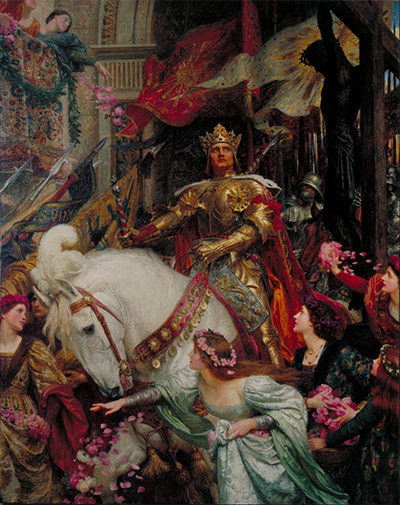Born Francis Bernard Dicksee on November 27th 1853, Frank did not fall far from the artistic lineage. His father, Thomas Dicksee was a celebrated painter who taught the young Frank and his sister Margaret how to paint from a young age.
His fame over the years has shown a good artistic upbringing, thanks to the family genes. As he grew in the industry, he received numerous accolades both from the government and the artistic association in England for his exemplary service. During his peak as a painter, he was given the title “Victorian Painter” by the Royal house; a Royal Victorian Order (named after Queen Victoria) designed by the British Monarch. He was also assimilated into Knighthood as a symbol of exemplary service to the commonwealth. In his field, the contribution he made for the growth of fine arts was commendable.
Throughout his formative years as a painter and illustrator, Frank leaned more towards Romanticism; the type of artistic expression that revolved around people; their emotions and subjectivity. He was big on portraits and figurative expressions and historical perspectives. Little is known about his family except for his father Thomas Dicksee, sister Margaret Isabel, brother Herbert Thomas and Uncle John Robert Dicksee. They were all painters, drawers and designers in their own right.
Early Training
Frank was born into painting and drawing. His father was a master painter who taught him the trade. He also learnt and emulated his uncle as they went about their business. The talent was there from the start, which made assimilation easier. He was enrolled into the Royal Academy of Arts, the English institution of liberal arts, at the age of 17 years. At the academy, he was transformed into a fine illustrative painter. His steadfast efforts would later lead him back to the institution as an academician after 20 years, and its president 34 years later.
He was big on colour, beauty and portraits. His influences were Frederic Leighton, a classical British painter and sculptor, and the idealist Henry Holiday who was big on landscape painting, illustrator and designer. Frank was consistent on Victorian ideals on art. His primary focus was history, Biblical events, portraits and social dramas. This push gave him acceptance in his career and made his theory a rallying call to subsequent painters, way after his death.
Travels and Career Development
Frank did not travel far in his career. He was a typical British painter who relied on his experiences and influences to draw. After being taught the basics by his father and enrolled at the Royal Academy, his journey was set. His first recorded painting was The Harmony in 1877. Here, his love for colours was vivid. Also, his depiction of romanticism was evident as it showed a lady playing the piano, much to the amusement of the listener.
19th Century
Frank tried a number of themes during this time. They included:
Romantic - Romeo and Juliet (1884), Passion (1892), Paolo and Francesca (1894), the Mirror (1896) and Chivalry (1885)
Portraits - Beatrice (1888)
History - Christ on the Cornfield (1883), The Funeral of a Viking (1893).
20th Century
Majority of his paintings which were neither dated not documented. Most of his works of art were pre-ordered and sold, which made it hard to be traced within the artistic circles. However, the ones that had timestamp included The End of the Quest (1921) and The Two Crown (1990). Some of his undated works include An Offering, It is I, Startled, La Belle Dame sans Merci (Beautiful Lady Without Pity) and the Victory; Knight Being Crowned. Portraits were also popular in his collection. He painted the aristocrats and wealthy people in society. They Included Thomas Ferens, Elsa, Cleopatra, Dorothy (Frank’s niece - 1917), Lady Palmer, Lady in a lace-edged Dress (1915) and Sylvia.
Exhibitions and Charity
He attended his first exhibition in 1921 at the Society of Graphic Arts. From there, he participated in various shows where his paintings grew in volume and design. However, most of his income was generated by painting portraits of beautiful maidens and wealthy people in society. One of his famous painting, Funeral of a Viking (1893) which was previously bought by Arthur Burton was donated to the Art Gallery in Manchester. The painting was later used by the Swedish Boy Band, Bathory, as a cover photo for their 1990 musical album. His other works were either donated to art studios and galleries across Europe or housed as private collections. All his artistic works were documented by Simon Toll in 2016, published by Antique Collector’s Club. He lived and represented British history and art to its fullest.
The Academy of Royal Arts
Most, if not all, of Frank’s life was spent at the Academy. He was first enrolled in 1870 as a student. His skills were exemplary which saw his involvement grow much faster. His peers elected him to the Academy in 1891 as a tutor. He taught at the institution until 1924 where he was elected President, succeeding Sir Aston Webb. Although he did not act as president for long, his inspiration saw him being recognised by the state for his contribution in arts.
Knighthood
Frank received his knighthood medal by the Monarchy in 1925 for his steadfast leadership in art circles. Two years later, King George the Fifth conferred him with the Royal Victorian Order. His name changed to Sir Francis Bernard Dicksee KVCO PRA.
Eventual Passing
Frank enjoyed good health throughout his life. His death on October 17th 1928 aged 74 years was sudden. However, his accolades gave him a tag as one of the finest British artists at the time and an astute administrator.




